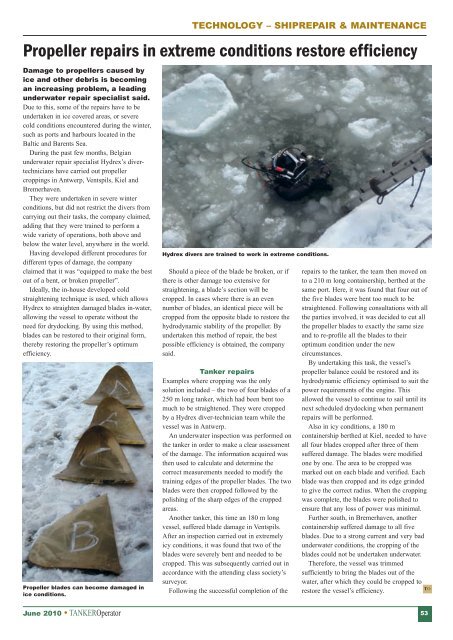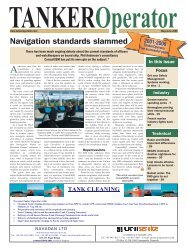Features: - Tanker Operator
Features: - Tanker Operator
Features: - Tanker Operator
You also want an ePaper? Increase the reach of your titles
YUMPU automatically turns print PDFs into web optimized ePapers that Google loves.
Damage to propellers caused by<br />
ice and other debris is becoming<br />
an increasing problem, a leading<br />
underwater repair specialist said.<br />
Due to this, some of the repairs have to be<br />
undertaken in ice covered areas, or severe<br />
cold conditions encountered during the winter,<br />
such as ports and harbours located in the<br />
Baltic and Barents Sea.<br />
During the past few months, Belgian<br />
underwater repair specialist Hydrex’s divertechnicians<br />
have carried out propeller<br />
croppings in Antwerp, Ventspils, Kiel and<br />
Bremerhaven.<br />
They were undertaken in severe winter<br />
conditions, but did not restrict the divers from<br />
carrying out their tasks, the company claimed,<br />
adding that they were trained to perform a<br />
wide variety of operations, both above and<br />
below the water level, anywhere in the world.<br />
Having developed different procedures for<br />
different types of damage, the company<br />
claimed that it was “equipped to make the best<br />
out of a bent, or broken propeller”.<br />
Ideally, the in-house developed cold<br />
straightening technique is used, which allows<br />
Hydrex to straighten damaged blades in-water,<br />
allowing the vessel to operate without the<br />
need for drydocking. By using this method,<br />
blades can be restored to their original form,<br />
thereby restoring the propeller’s optimum<br />
efficiency.<br />
TECHNOLOGY – SHIPREPAIR & MAINTENANCE<br />
Propeller repairs in extreme conditions restore efficiency<br />
Propeller blades can become damaged in<br />
ice conditions.<br />
Hydrex divers are trained to work in extreme conditions.<br />
Should a piece of the blade be broken, or if<br />
there is other damage too extensive for<br />
straightening, a blade’s section will be<br />
cropped. In cases where there is an even<br />
number of blades, an identical piece will be<br />
cropped from the opposite blade to restore the<br />
hydrodynamic stability of the propeller. By<br />
undertaken this method of repair, the best<br />
possible efficiency is obtained, the company<br />
said.<br />
<strong>Tanker</strong> repairs<br />
Examples where cropping was the only<br />
solution included – the two of four blades of a<br />
250 m long tanker, which had been bent too<br />
much to be straightened. They were cropped<br />
by a Hydrex diver-technician team while the<br />
vessel was in Antwerp.<br />
An underwater inspection was performed on<br />
the tanker in order to make a clear assessment<br />
of the damage. The information acquired was<br />
then used to calculate and determine the<br />
correct measurements needed to modify the<br />
training edges of the propeller blades. The two<br />
blades were then cropped followed by the<br />
polishing of the sharp edges of the cropped<br />
areas.<br />
Another tanker, this time an 180 m long<br />
vessel, suffered blade damage in Ventspils.<br />
After an inspection carried out in extremely<br />
icy conditions, it was found that two of the<br />
blades were severely bent and needed to be<br />
cropped. This was subsequently carried out in<br />
accordance with the attending class society’s<br />
surveyor.<br />
Following the successful completion of the<br />
repairs to the tanker, the team then moved on<br />
to a 210 m long containership, berthed at the<br />
same port. Here, it was found that four out of<br />
the five blades were bent too much to be<br />
straightened. Following consultations with all<br />
the parties involved, it was decided to cut all<br />
the propeller blades to exactly the same size<br />
and to re-profile all the blades to their<br />
optimum condition under the new<br />
circumstances.<br />
By undertaking this task, the vessel’s<br />
propeller balance could be restored and its<br />
hydrodynamic efficiency optimised to suit the<br />
power requirements of the engine. This<br />
allowed the vessel to continue to sail until its<br />
next scheduled drydocking when permanent<br />
repairs will be performed.<br />
Also in icy conditions, a 180 m<br />
containership berthed at Kiel, needed to have<br />
all four blades cropped after three of them<br />
suffered damage. The blades were modified<br />
one by one. The area to be cropped was<br />
marked out on each blade and verified. Each<br />
blade was then cropped and its edge grinded<br />
to give the correct radius. When the cropping<br />
was complete, the blades were polished to<br />
ensure that any loss of power was minimal.<br />
Further south, in Bremerhaven, another<br />
containership suffered damage to all five<br />
blades. Due to a strong current and very bad<br />
underwater conditions, the cropping of the<br />
blades could not be undertaken underwater.<br />
Therefore, the vessel was trimmed<br />
sufficiently to bring the blades out of the<br />
water, after which they could be cropped to<br />
restore the vessel’s efficiency.<br />
June 2010 TANKER<strong>Operator</strong> 53<br />
TO
















